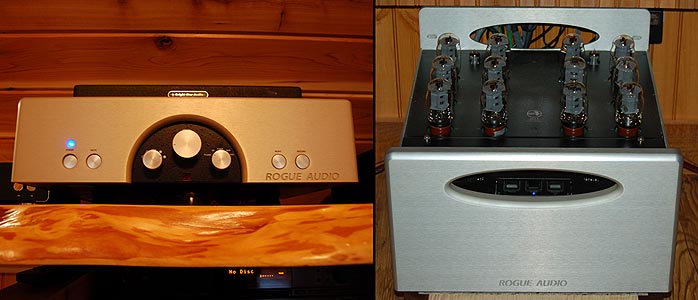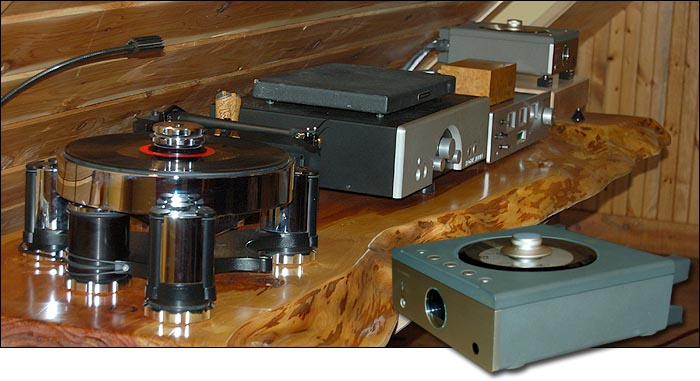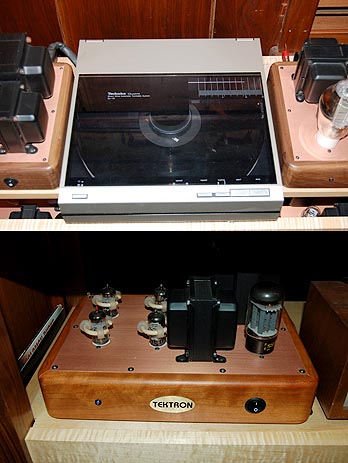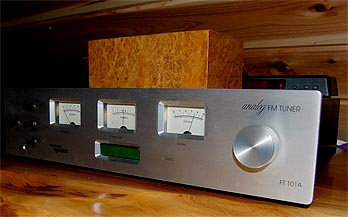|
This review page is supported in part by the sponsor whose ad is displayed above
|
||||||||||||||||
 |
||||||||||||||||
 |
||||||||||||||||
Owner: Robin W. System 3 Analog: Avid Acutus, SME V, Stanton cs100 Digital: Monica II DAC, custom Marantz CDP (1 of 2 in world) Tuner: Magnum Dynalab FT 101A tuner modified by Don Scott, Wingard antenna plus rotor Preamp: Rogue 99 Magnum with CV181s Amp: Rogue Zeus with Valve Art KT66s Speakers: Tannoy Wideband Churchills (1 of 10 in the world) in Santos rosewood Cables: Poth Audio Interconnects, Stealth Varidig Sextet Digital cable, Cardas Golden Cross Speaker cable (to be replaced by Poth custom tri-wired cables) and Poth Audio power cords Tweaks: Herbie's Audio Labs HAL-Os tube dampers, Herbie's Iso-Cup footers under preamp, Symposium Rollerblocks Series II under CD player, Bright Star Big Rock on preamp Power: 2 x 20A lines from service panel to equipment Room size: 26' x 26' Listener: Michael Lavorgna |
||||||||||||||||
 |
||||||||||||||||
Exit 3B: An Island in Pennsylvania Roughly one hour and thirty minutes due west from Robin's NJ home lies Paws Pond. This former hunting cottage acts as the weekend getaway for Robin and his family. Paws Pond is nestled amongst the pines and there is in fact a pond and year-round stream running through it. The operative word being lovely. While the Corgis terrorized the horses outside, we retreated into the warmth and comfort of the dedicated listening room. System 3 Tannoy The Tannoy Wideband Churchills are a limited production run. The 'wideband' in the name refers to the inclusion of the T200 super tweeter. According to Robin, we were listening to one of ten pairs in existence. Perhaps the Churchills' most distinguished visual trait is that bloody bold V port smack dab in the center of these pair-matched Santos Rosewood veneered trapezoids. I've read claims that the port design is purely functional and any visual reference beyond that coincidental. Since I read this statement, there was no way to tell the extent of the Cheshire cat smile accompanying it. |
||||||||||||||||
 |
||||||||||||||||
The Churchills sport a 15" dual-concentric driver in addition to the aforementioned super tweeter and have a reported frequency response of 32Hz to 47kHz. As I hope you can see, these speakers cut a striking pose and I dare say are a tad more attractive than their honorary father at 48.75 x 22.5 x 22.5 inches (H x W x D). If you've ever heard the Churchills, you know that reported frequency response is more conservative than pin stripes, polo and a shaken martini. |
||||||||||||||||
 |
||||||||||||||||
Round back sit the tri-wireable binding posts and above that the "Custom Shelving Matrix'. This matrix allows the owner to adjust crossover points in 1dB increments for four ranges and hence tailor the sound to the room. The Churchills are rated at 95dB and recommended power is 5 to 500 watts. The dual-concentric raison d'être is to deliver point-source dispersion just like a single-driver speaker while at the same time employing separate drivers for extended bandwidth. Looking at the drivers in the Churchills, you can see how the tweeter shares the same axis as that 15"er. Tannoy has been at this coaxial or dual-concentric design for nearly 60 years. Tannoy was founded in 1926 by Guy Fountain and produced their first dual concentric loudspeaker in 1948. To say their earlier drivers are highly sought after would be like saying a Van Gogh is a cool garage sale find. If you've ever priced vintage Tannoy dual concentric drivers on eBay like the 15" Silver, you know how pricey they are. One pair was recently fetching over $6,000. |
||||||||||||||||
 |
||||||||||||||||
| Rogue Audio Sitting squarely between the Churchills is the Rogue Audio Zeus power amplifier. Rated at 225wpc in Ultra Linear mode and sporting a clean dozen Valve Art KT66s (Robin's tube of choice while the Zeus is typically supplied with KT-88s), the Zeus is 200lbs of musical muscle. The Zeus sits at the top of the Rogue amp lineup and is priced at $6,995 (with cover) according to Rogue's website. While finding pricing information on a manufacturer's site is not unheard of, I always find it refreshing. Without crossing over into reviewerville, it is interesting to add up what you get with a Zeus -- or any other piece of Rogue gear -- and then compare the price, parts and performance to other stuff. Now where was I? Ah yes, some user-friendly features include the ability to individually bias each tube using the built-in meter and on-the-fly-switching from Ultra Linear to Triode operation. The remote-controlled Rogue Audio Ninety-Nine Magnum takes on preamplification duties and sports Robin-swapped CV-181s in place of the stock 6SN7s. The CV181s can be majorly microphonic, explaining the Bright Star Big Rock atop the Ninety-Nine. The "Magnum" in the name signifies that this is the most recent version incorporating a number of upgrades over the original model, including a larger power supply, extensive power supply mods, ultra high quality coupling and output capacitors, Harmonic Technology silver wiring (unshielded), gold tube sockets, upgraded tube set, additional Dale-Vishay resistors and the Magnum faceplate and blue LED. There's an external power supply and the remote is machined aluminum. What else would you expect for $2,995 with phono stage? |
||||||||||||||||
 |
||||||||||||||||
6moons' Edgar Kramer reviewed the Rogue M150 amp back in June 2005 and here's an excerpt from how he opened his review:"... Matter of fact. To the point! And that's just how some audio manufacturers present themselves and their equipment. No bullshit, just straightforward honest gear that often surprises the auditioner or potential buyer with tier-defying sonic quality and value for money. More often than not, such gear conceals its merit underneath the covers, as though the hidden parts quality and astute engineering were blushing with pre-nuptial innocence and modesty. Rogue Audio strike me as one of these modest yet quietly achieving brands that strive to provide well-designed value-for-money products commensurate with audiophiles' stringent sonic demands..." |
||||||||||||||||
 |
||||||||||||||||
Avid The Avid Acutus is another visual spectacle of a turntable, its stunning polished chrome perhaps deflecting thoughts from the serious engineering within. The three columnar supports contain some heavy-duty sprung spring suspension and the fourth column conceals the motor. The Acutus is belt-driven and from designer Conrad Mas, we learn that "a purpose designed power supply cis oupled to a unique handmade motor -- 10 times more powerful than normally used -- to drive a massive 10kg platter." The Acutus sits at the top of the Avid lineup which includes three other models, the Volvere Sequel, Volvere and Diva. If you take a close look at the beams protruding from the wall supporting that great big slab of beautiful burl... you can't see but I know that those beams are bolted to the ceiling joists to avoid floor-induced vibration. Well, vibes can be funnily determined little buggers and Robin found the Acutus to be the turntable of choice to successfully stave off unwanted vibrations while delivering the musical goods. Finishing up the vinyl setup is the SME V arm and the Stanton cs100 cartridge. |
||||||||||||||||
 |
||||||||||||||||
| Marantz and DIY Paradise That Marantz is another rare breed found at Paws Pond, being one of only two units ever made. It was actually built as a show piece and is in fact a full-blown player having four internal DACs. But -- and this is one of those really interesting buts -- Robin prefers the external DIY-Paradise Monica 2 DAC. This is the same DAC that Vinnie of RedWine Audio uses in his custom DAC installation. That Marantz had a retail of something like $4K and we did an A/B against its internal DACs with the $125-for-the assembled/tested-board Monica 2. There was no question in my ears which I preferred; Monica all the way. The Monica 2 is another non-oversampling DAC descended from the same Kusunoki-inspired lineage as 47Labs, Zanden, Ack!, Audio Note and others. The Monica sounded more natural and musical, leaving the Marantz sounding - well, digital. Robin had that custom Bird's eye maple enclosure made and you also have to provide your own power supply if you purchase your Monica 2 through DIY Paradise. Going this route, the total cost comes out to a few hundred dollars depending on how crazy you go with the enclosure. Or, you can try one of Vinnie's ready-to-roll battery-powered models for a cool $450. Here's something interesting to ruminate on; Robin uses the Combak Reimyo CD-777 player in his NJ rig and he listens to the Monica 2 DAC out here in PA. |
||||||||||||||||
 |
||||||||||||||||
| Poth Audio Funny that I wasn't familiar with Poth Audio cables. They're made in Flemington/NJ only a few miles from my home. The Poth Audio interconnects employed on all single-ended connections throughout the system are hand-made by Jeff Poth of "ultra high quality silver". Priced at $250 for a 1-meter pair, the Poth cables are another well-priced find. A pair of the Poth Audio tri-wired speaker cables is in the works. Another casual observation gleaned from the various Robin systems is keeping the cable manufacturer consistent throughout the system. Stealth in the NJ big rig, Poth up here in PA and Alpha Core downstairs where we'll go next. Another "do not mix'n'match" theme can be seen in the amp/pre combos; Rogue, Air Tight, Tektron, and Fi. Tweaks Some tweaks that traveled to PA with Robin including Herbie's Halo-s, Symposium Series II Rollerblocks under the Marantz drive and Herbie's Iso-Cup footers under the preamp. The concert hall in PA Back in Jersey [RoadTour Exit 3 - Ed], we heard 22 SET watts into 7ft tall 98dB towers sporting a total of 4 x 12" woofers. Here in PA we have 225 Ultra Linear watts into 95dB 15" dual concentrics in a stouter cabinet. And the winner is? How about breeds instead. This Zeus/Churchill combo can kick some music-lovin' killer butt and I'd go so far as to suggest that it has a nearly unlimited amount of dynamic, earth-shaking, air-moving, super tuneful lowest-low to ultra-highest room-energizing slama-lama-ding-dong. I've heard deep bass but I've never heard truly tuneful deep bass especially at the volume levels produced at Paws Pond. And just when you thought the system -- or perhaps your ears -- could take no more massed music, some whacks of a kettle drum convinced your ears you'd scored the trust fund seats at The Concert Hall. Color me impressed. The only sense of a limiting factor is the already large listening room. It could be larger still. This system gives you the distinct impression that it can keep playing louder into bigger spaces. And at lower volumes, the music remains coherently whole from top to bottom. Nearly -- and I know this, cough, sounds hard to swallow -- intimate. Once again, the tunes were delightful and included a wide array of styles and flavors, from Bizet's Carmen to the Rolling Stones, James Blunt, Peggy Lee, Miles Davis, Barry White and a host of others. On the Rolling Stones track "Laugh I Nearly Died" from the LP Bigger Bang, you could feel -- and at the volume levels we were playing I mean feel -- Mick Jagger move around the mic as he sang. I'm not talking about some hi-fi soundstage-y artifact but this very natural sensation that there's a guy singing and moving around while he's doin' it. This goes into the categories rarely heard and man that's kinda freaky. Physicality delivered. |
||||||||||||||||
 |
||||||||||||||||
| System 4 Analog: Technics SL-10, Ortofon Super OMP-40 Digital: Sony ES777, Benchmark DAC Tuner: KLH Model 11 modified by Don Scott, XM Radio Preamp: Tektron TK6J5, Tektron TKPHMM phono stage Amp: Tektron TK2A3/50M Speakers: Horn Shoppe Horns Cables: Alpha Core Sapphire interconnects and MI2 speaker cable Tweaks: Herbie's Audio Labs HAL-Os tube dampers Downstairs in the Reading Room You knew there had to be another system here, didn't you? Well, down in the reading room sits the relaxing and reading rig. This is an intimate space and pushes the nearfield limit to within a few feet of the speakers. Not claustrophobic mind you, since the view out that picture window is something to take in over time. |
||||||||||||||||
The Horn Shoppe Yep, that's another pair of Ed Shilling's Horns sitting amazingly close to both the rear wall and the listening seat yet they made some lovely music and produced credible bass yet again. This pair leaves the Fostex FE 108 Sigma driver intact, no wooden dust cap replacement. Ed Shilling has apparently flipped over the new Fostex Fe 126E drivers and every Horn leaving South Carolina is now so equipped. [Stay tuned for a future review when my personal pair escapes the clutches of Art Dudley who kindly agreed to break them in for me while he labors over his follow-up for Stereophile. Leave something for me to say, Art. - Ed] Owners can retro-fit. For a 30" tall, 11.5" deep and 6" wide loudspeaker costing $820 delivered (in red oak), any single-driver-minded, budget-wise music lover would be daffy to pass these by without at least a listen. Tektron Driving the Horns are the Tektron TK2A3/50M monoblocks (that's what the "M" is there for). These Tektron amps can play 2A3s, 45s, 245s, 345s, 300Bs, 50s, 250s, 350s and VT52s. Soon to be a full-featured review, I'm purposely skimming. To whet those tube-swapper appetites, Robin did in fact play both the Sophia SET Princess classic tube and an NOS pair of Cunningham 50s swapping mid-music. And the tube angles wept (again). In front of the amp are the Tektron TK6J5 preamp and the TKPHMM phono stage, all point-to-point hand-wired affairs. The preamp is coming in for review as well so stay tuned for an in-depth look. |
 |
|||||||||||||||
| Sony and Benchmark A Sony ES777 CD player and Benchmark DAC share digital front end duties. The Benchmark is also used for headphone listening and a pair of Sonys take up pride of place in the ear goggle department. Both the Sony and XM Delphi are run through the Benchmark digital converter. Technics That turntable in a box is an 80's vintage quartz direct-drive Technics SL-10 with an Ortofon Super OMP-40 cartridge. The Technics table is another eBay purchase and a very reasonably priced one at that. This combo made some wonderful music together and Solomon Burke was given a faithful bodily rendition through the Horns. I own this recording on CD and the vinyl version on this setup was more , shall we say tangible. I did a little on-line research on the Technics table and beyond its DJ appeal due to near-instantaneous start-up and effective vibration damping, there's a more general lesson to be learned when Googling specific audio gear by model number. If the majority of your search results are from sites that end in .jp, you're onto something worth pursuing. |
||||||||||||||||
 |
Alpha Core Goertz The Alpha Core Sapphire Silver interconnects are employed throughout the Tektron rig and the MI2 copper speaker cables wire up the horns. For those with the time to explore Alpha Core's labyrinthine website, there's a heap of real information on their extensive and well-priced cables. To each his own in animals and audio Once again, the relaxed system delivered some intimate sounds and you'd be hard pressed not sit back, enjoy the fire and the great tunes while watching those little 26lb Welsh Pembroke Corgis go after those 1000lb horses like they were some bad-assed ninjas. After they were finished harassing the penned steeds, the Corgis came inside for a little human touch, perhaps to rest on a warm friendly lap in the sweet spot of the reading room. Did you know there are 147 American Kennel Club- recognized dog breeds? And another 22 unrecognized breeds not counting the many mutt variants? Well, don't think of the number of possible successful combinations of audio gear like different breeds of canines. That's too narrow a sampling, too limited a palette. Even here at Paws Pond, it just won't cut it. While we have one intimate system and one grand yet again, I was hoping for a more colorful picture to leave you with a stronger impression. Oh well, I suppose that'll have to do. Before I left Paws Pond, Robin was kind enough to show me around and I got better acquainted with the house, the grounds and the animals. As a matter of fact, I had the opportunity to saddle up one of those Corgis for a spirited ride around the grounds. When I was back inside warming by the fire, one of the ponies came in for a rest and perched its 1000lbs comfortably on my lap. Opening photos of Paws Pond provided by Robin's daughter Jacqui W. |
|||||||||||||||
 |
||||||||||||||||
 |
||||||||||||||||
|
Robin's website
|
||||||||||||||||
 |
||||||||||||||||